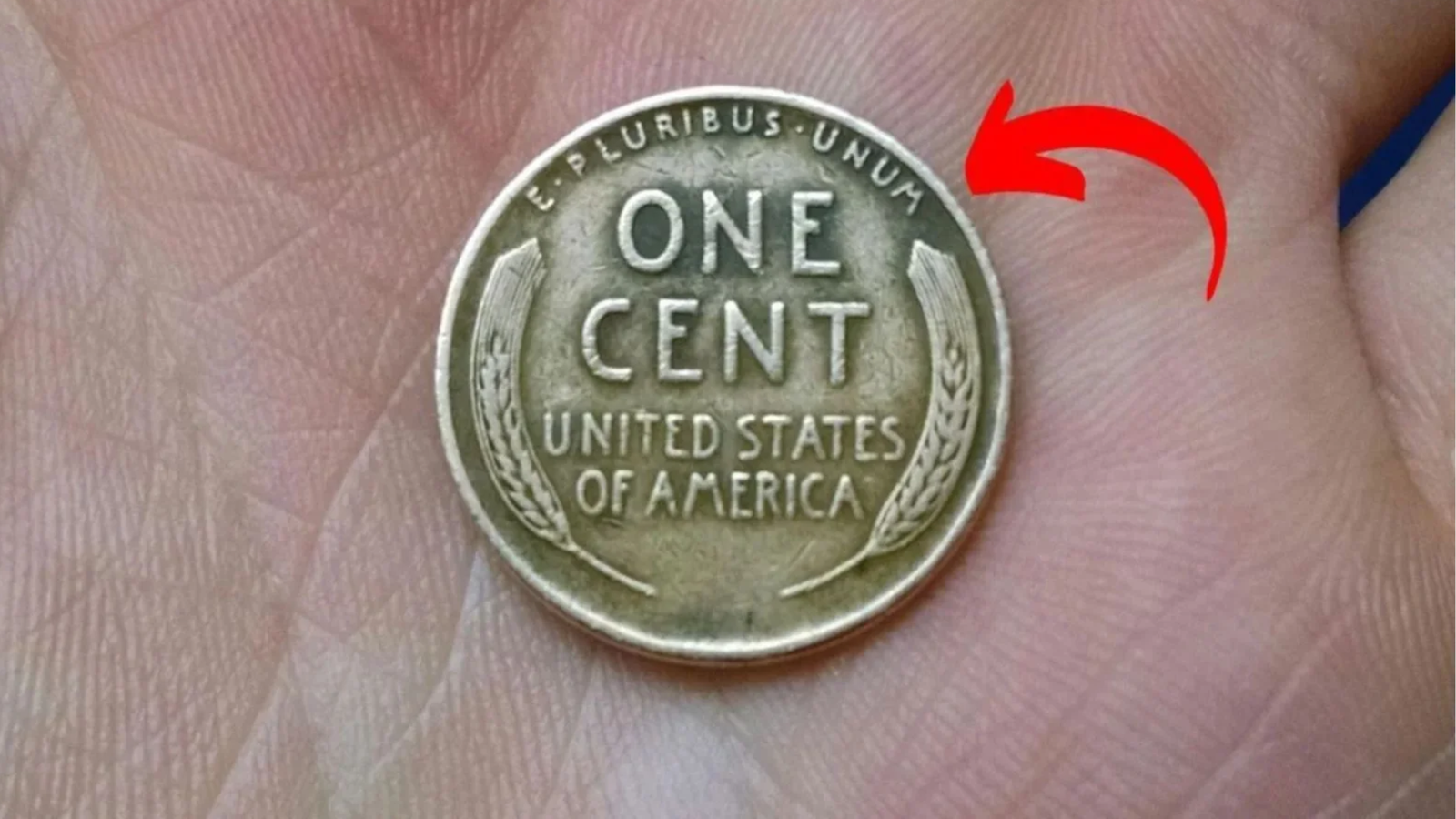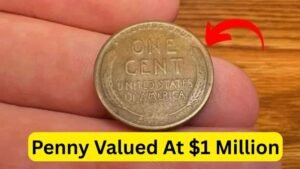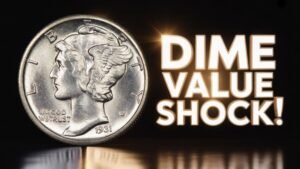The Lincoln Wheat Penny, launched in 1909 to honor Abraham Lincoln’s 100th birthday, was the first U.S. coin to feature a real person’s portrait. Designed by Victor David Brenner, the front shows Lincoln facing right, with “IN GOD WE TRUST” above and “LIBERTY” near the date. The back has two wheat stalks encircling “ONE CENT” and “UNITED STATES OF AMERICA,” symbolizing America’s agricultural roots.
From 1909 to 1958, the U.S. Mint produced over 100 billion in Philadelphia (no mint mark), Denver (D), and San Francisco (S). Most are 95% copper with tin and zinc, weighing 3.11 grams and shining red when fresh.
In 1943, to save copper for World War II, most pennies were zinc-coated steel, appearing gray and weighing 2.7 grams. By 1982, rising metal costs led to zinc cores with copper plating. Common ones are worth one cent, but in 2025, with copper at $4.50 per pound, their melt value is 2-3 cents. Rare dates and errors make them collector favorites, often hiding in pocket change, bank rolls, or old stashes.
Why Wheat Pennies Vary in Value By Year
A Wheat Penny’s worth depends on its year, condition, and unique traits. Years with low mintages—fewer coins made—are scarcer and pricier. Condition, rated from 1 (worn) to 70 (perfect) by experts, boosts value for shiny coins. Errors, like wrong metals or double stamping, create rarities that collectors chase.
In 2025, nostalgia and rising copper prices drive a 15% value increase for key dates and errors. Social media, like Reddit’s r/coins, fuels demand, but beware fakes—authentication is crucial.
Key Years and Varieties to Hunt For
Certain years and errors stand out for their value and stories. Here’s what to look for:
Early Years (1909-1919): Rare Beginnings
Low mintages and early designs make these valuable.
1909-S VDB
Designer’s initials “VDB” on back; only 484,000 minted in San Francisco. Worth $500-$168,000 in good condition.
1914-D
Denver’s low run of 1.2 million; $200-$20,000.
Mid Years (1920-1939): Depression Scarcity
Economic hardship cut mintages, increasing rarity.
1922 No D
Missing Denver mint mark due to a worn die; $300-$10,000.
1931-S
Only 866,000 made during the Great Depression; $50-$1,500.
Later Years (1940-1958): Wartime Errors
World War II led to unique mistakes.
1943 Bronze
Bronze blanks used in a steel year; ~20 known (12 Philadelphia, 4 Denver, 1 San Francisco). $50,000-$1.7 million.
1944 Steel
Steel in a bronze year; $5,000-$115,000.
1955 Doubled Die Obverse
Bold doubling on date and “LIBERTY”; $800-$125,000.
Table of Wheat Penny Values By Year in 2025
Based on 2025 Heritage Auctions and PCGS data, here’s a guide for VF-20+ condition (fine or better):
| Year | Mint | Key Feature | Mintage (Approx.) | Value Range | Notes |
|---|---|---|---|---|---|
| 1909 | S VDB | Initials on back | 484,000 | $500-$168K | First year rarity |
| 1914 | D | Low production | 1.2M | $200-$20K | Scarce in high grade |
| 1922 | No D | Missing mark | Unknown | $300-$10K | Die error |
| 1931 | S | Depression low | 866,000 | $50-$1.5K | San Francisco scarcity |
| 1943 | Bronze | Wrong metal | Unknown (~20) | $50K-$1.7M | War error |
| 1944 | Steel | Wrong metal | Unknown (rare) | $5K-$115K | Reverse error |
| 1955 | P | Doubled die | 20,000-24,000 | $800-$125K | Bold front doubling |
| 1909 | S | Early S-mint | 1.8M | $400-$15K | Without VDB |
| 1926 | S | Low S-mint | 4.5M | $50-$2.5K | Depression era |
| 1942 | P | Subtle doubling | Normal | $20-$1K | Minor error |
Red (shiny) condition adds 20-50%; melt value is 2-3 cents.
How to Spot a Valuable Wheat Penny
Think you’ve found a keeper? Try these steps:
- Check the Year: Focus on 1909, 1914, 1922, 1931, 1943, 1944, 1955—top value years.
- Look for Mint Marks: Below the date; “S” or “D” often means more worth.
- Spot Errors: Use a 10x loupe for doubling (1955) or color (1943 bronze is red, not gray).
- Weigh It: Copper is 3.11g; steel 2.7g. A cheap scale confirms.
- Test with Magnet: Steel sticks; bronze doesn’t.
- Condition: Clear wheat lines and shine mean higher value.
Avoid cleaning—natural tone is prized. Apps like CoinSnap help identify finds.
Where to Find Wheat Pennies in 2025
Look for these coins in:
- Loose Change: Vending machines, tip jars, or store change—check for old dates.
- Bank Rolls: $25 buys 2,500 pennies; sort by year at home.
- Old Stashes: Family jars, estate sales, or thrift stores.
- Coin Shows: Buy or trade mixed lots affordably.
- Online: eBay or Etsy for bulk penny bags.
In 2025, with less cash use, rolls and stashes are prime hunting grounds.
Selling Your Wheat Pennies for Top Value
To cash in on finds:
- Authenticate: PCGS or NGC grading ($20-50) provides a protective slab and boosts trust.
- Sell Smart: eBay for quick sales, local shops for instant cash, Heritage Auctions for high bids (10-15% fees).
- Timing: 2025’s error coin market is hot—graded Red coins sell fastest.
Uncertified commons may fetch $1-5; graded rarities soar.
Conclusion
Lincoln Wheat Pennies by year offer a thrilling mix of history and hidden value, from the $1.7 million 1943 bronze to the $168,000 1909-S VDB. These copper coins, with Lincoln’s profile and wheat stalks, connect us to America’s past in 2025’s booming collector market. Billions are still out there, so grab a loupe, check your change, and verify with experts. The real treasure is the joy of the hunt.
FAQ
What makes a Wheat Penny valuable?
Low mintage, great condition, or errors like wrong metal or doubling increase worth.
Which Wheat Penny year is worth the most?
The 1943 bronze, up to $1.7 million, is the rarest.
Can I find Wheat Pennies in change?
Yes, but rare—check bank rolls or old jars.
What’s the melt value of a Wheat Penny?
2-3 cents for copper in 2025.
Should I clean Wheat Pennies?
No—cleaning scratches reduce value. Keep natural.
Where to sell a rare Wheat Penny?
Grade with PCGS/NGC, then try eBay or Heritage Auctions.




